Looking for the ultimate kitchen sidekick? Look no further than the tantalizing world of cookware materials! Choosing the best cookware material can be as crucial as picking the perfect recipe—it sets the stage for culinary magic or culinary mishaps.
From the sleek allure of stainless steel to the rustic charm of cast iron, each material brings its own flair to the cooking experience.
Let’s dive into the sizzling journey of discovering the best cookware material that suits your culinary prowess and elevates your kitchen adventures to a whole new level of deliciousness!
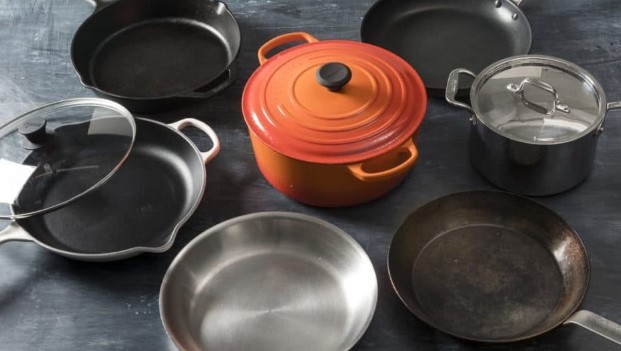
Best Cookware Material
When choosing the best cookware material for a frying pan, consider factors like heat conductivity, durability, and ease of maintenance. Stainless steel is a popular choice due to its durability and non-reactivity with food.
Cast iron offers excellent heat retention and is great for searing and frying. Non-stick pans, coated with materials like Teflon or ceramic, are easy to clean and require less oil for cooking.
Copper pans provide superior heat conduction but may require more maintenance to keep them looking their best. Ultimately, the best material depends on your cooking style and preferences.
Qualities To Look For In Cookware
When choosing cookware, consider these essential qualities:
Durability
Durability is a key factor to consider when selecting cookware. Materials like stainless steel, cast iron, and hard-anodized aluminum are known for their long-lasting durability, resisting scratches, dents, and warping over time.
This ensures that your cookware can withstand frequent use, high temperatures, and rigorous cooking techniques without compromising its performance or appearance.
Investing in durable cookware not only saves money in the long run but also provides reliability and consistent cooking results for years to come.
Heat Distribution
Heat distribution is crucial for achieving evenly cooked dishes. Cookware with excellent heat distribution ensures that food cooks uniformly without hot spots or uneven cooking.
Materials like copper and aluminum are known for their superior heat conductivity, allowing heat to spread evenly across the cooking surface. This results in consistent cooking results and helps prevent burning or undercooking of food.
Choosing cookware with optimal heat distribution enhances cooking precision, making it easier to achieve perfect results every time you cook.
Induction Compatibility
Induction compatibility is important for those using induction cooktops, which rely on magnetic fields to heat cookware directly.
Look for cookware with a magnetic base, such as stainless steel with a ferrous bottom or cast iron, to ensure compatibility with induction cooktops. This allows for efficient heat transfer and precise temperature control, making induction cooking both fast and energy-efficient.
Check cookware labels or specifications to confirm their compatibility with induction stovetops before purchasing to ensure seamless and effective cooking experiences.
Acid Reactivity
Acid reactivity refers to how cookware reacts with acidic ingredients, such as tomatoes or citrus fruits.
Materials like cast iron and stainless steel are generally non-reactive with acids, making them suitable for cooking acidic dishes without affecting the taste or color of the food.
Avoid using reactive materials like aluminum or copper directly with acidic foods, as they can impart a metallic taste and discoloration to the dish.
Choosing non-reactive cookware ensures that your meals retain their flavors and appearance, especially when cooking dishes with high acidity.
Ease of Maintenance
Ease of maintenance is a key consideration when selecting cookware, as it impacts the longevity and usability of your pots and pans.
Non-stick coatings, such as Teflon or ceramic, are known for their easy cleanup, requiring minimal scrubbing and preventing food from sticking. Stainless steel and enamel-coated cookware are also relatively easy to maintain, as they resist stains and are dishwasher-safe.
Cast iron, while durable, may require seasoning and hand washing to maintain its non-stick properties and prevent rusting.
Consider your cleaning preferences and lifestyle when choosing cookware to ensure hassle-free maintenance and long-term enjoyment of your kitchen tools.
Materials And Their Advantages & Disadvantages
Now that we have an idea of the qualities to consider in cookware, let’s discuss the different pan materials and their advantages and disadvantages.
Here’s a breakdown of different pan materials and their pros and cons:
Cast Iron
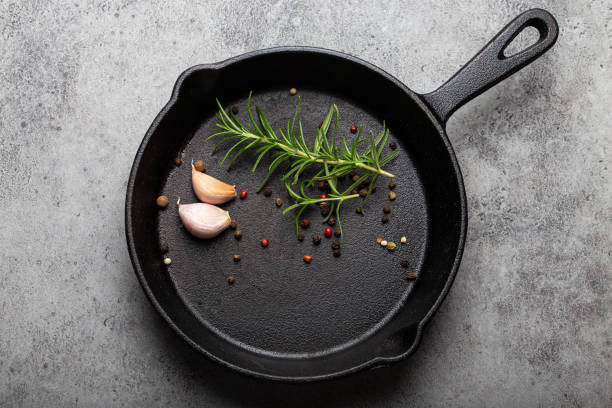
Cast iron cookware is renowned for its durability and versatility in the kitchen. These pans are excellent at retaining heat, making them ideal for tasks like searing and frying.
Their non-stick properties improve with seasoning, creating a natural barrier against sticking without the need for added oils. However, they do require regular maintenance, including seasoning to prevent rusting and maintain their non-stick surface.
Moreover, cast iron pans can be heavy and may take longer to heat up compared to other materials. Despite these considerations, their longevity and cooking performance make them a favorite among chefs and home cooks alike.
Advantages of Cast Iron
- Excellent Heat Retention: Holds heat evenly and maintains temperature for consistent cooking.
- Natural Non-Stick Surface: Develops a non-stick coating with seasoning, reducing the need for excessive oil.
- Versatility: Suitable for stovetop, oven, and even outdoor cooking.
- Adds Iron to Food: Provides a nutritional benefit by leaching small amounts of iron into cooked food.
- Durable: Resistant to scratches and long-lasting with proper care.
Disadvantages of Cast Iron
- Requires Maintenance: Needs regular seasoning to maintain its non-stick properties and prevent rust.
- Heavy: Can be cumbersome to handle, especially for larger pans.
- Slow to Heat Up: Takes longer to reach desired cooking temperatures compared to some other materials.
- Can React with Acidic Foods: Not ideal for cooking highly acidic dishes, as it can affect the flavor and appearance of the food.
Enameled Cast Iron
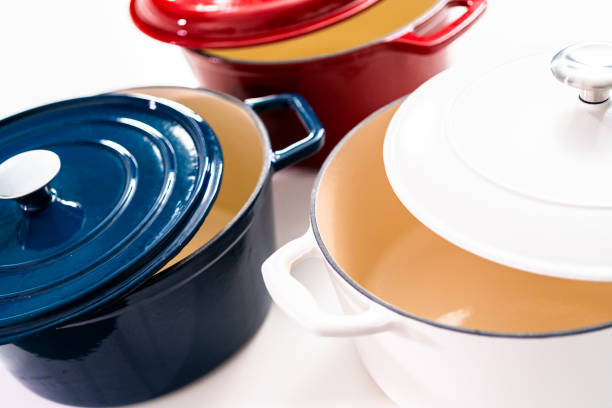
Enameled cast iron cookware combines the durability of cast iron with the benefits of an enamel coating. These pans have a smooth, non-porous surface that doesn’t require seasoning like traditional cast iron.
The enamel coating also prevents rusting and makes them easier to clean. However, enameled cast iron can be more expensive than regular cast iron, and the enamel may chip or crack over time if not handled carefully.
Despite these considerations, many cooks appreciate the even heat distribution and versatility of enameled cast iron for various cooking tasks.
Advantages of Enameled Cast Iron
- Non-Stick Surface: The enamel coating provides a smooth, non-stick surface without the need for seasoning.
- Durable: Resistant to rusting and scratching, making it long-lasting with proper care.
- Easy to Clean: The non-porous surface is easy to clean and doesn’t absorb odors or flavors.
- Versatility: Suitable for stovetop, oven, and even table serving due to its attractive appearance.
- Even Heat Distribution: Distributes heat evenly for consistent cooking results.
Disadvantages of Enameled Cast Iron
- Cost: Generally more expensive than traditional cast iron cookware.
- Enamel Care: The enamel coating can chip or crack if subjected to rough handling or extreme temperature changes.
- Weight: Like cast iron, enameled cast iron can be heavy and may require extra care when handling.
Overall, enameled cast iron is a popular choice for those who want the benefits of cast iron with added convenience and aesthetics.
Non-Stick
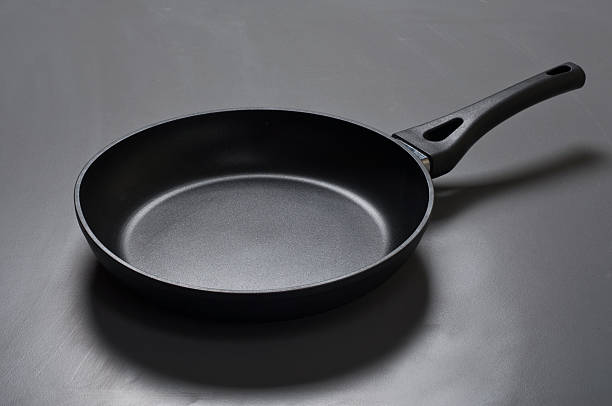
Non-stick cookware is designed with a coating that prevents food from sticking to the surface during cooking, making it easier to clean and requiring less oil or butter for cooking.
This type of cookware is often made with materials like Teflon or ceramic coatings. However, non-stick cookware may not be suitable for high-heat cooking or use with metal utensils, as this can damage the non-stick coating.
Moreover, some concerns have been raised about the safety of certain non-stick coatings when exposed to high temperatures. Despite these considerations, non-stick cookware remains popular for its convenience and ease of use in everyday cooking.
Advantages of Non-Stick Cookware
- Easy to Clean: Food slides off easily, reducing the need for soaking or scrubbing.
- Requires Less Oil: Cooking with less oil or butter for healthier meals.
- Versatile: Suitable for cooking delicate foods like eggs, fish, and pancakes without sticking.
- Lightweight: Typically lighter than cast iron or stainless steel cookware, making it easier to handle.
- Affordable: Available at various price points to suit different budgets.
Disadvantages of Non-Stick Cookware
- Limited Durability: Non-stick coatings can wear off over time, especially with metal utensils or abrasive cleaning.
- Not for High Heat: Not recommended for high-heat cooking, as it can damage the non-stick coating and release harmful fumes.
- Safety Concerns: Some non-stick coatings may pose health risks when exposed to very high temperatures.
- Requires Careful Handling: Avoid using metal utensils or harsh cleaners to prolong the lifespan of the non-stick coating.
Overall, non-stick cookware is a convenient option for everyday cooking tasks but requires proper care and maintenance to ensure longevity and safety.
Stainless Steel
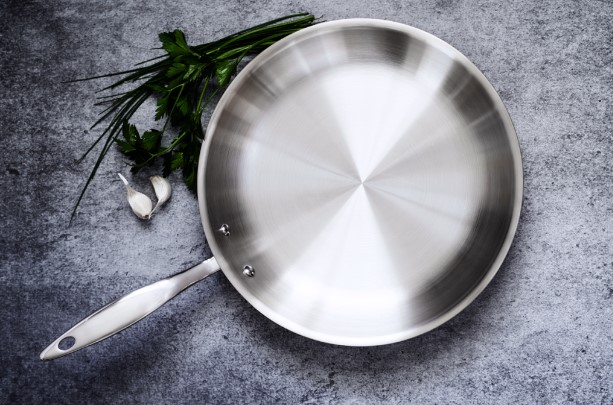
Stainless steel cookware is known for its durability, versatility, and sleek appearance, making it a popular choice in kitchens worldwide.
This type of cookware is made from an alloy of steel and other metals like chromium and nickel, which gives it its non-reactive and corrosion-resistant properties.
However, stainless steel alone is not a good conductor of heat, so it’s often layered or bonded with materials like aluminum or copper to improve heat distribution.
While stainless steel cookware is relatively easy to clean and maintain, it may require some oil or liquid to prevent food from sticking during cooking.
Advantages of Stainless Steel Cookware
- Durability: Resistant to scratches, dents, and corrosion, making it long-lasting.
- Non-Reactive: Does not react with acidic or alkaline foods, preserving flavors and colors.
- Versatility: Suitable for various cooking methods, including stovetop, oven, and induction cooktops.
- Easy to Clean: Stainless steel is dishwasher-safe and does not retain odors or flavors.
- Attractive Appearance: Sleek and modern design adds aesthetic appeal to the kitchen.
Disadvantages of Stainless Steel Cookware
- Heat Conductivity: Pure stainless steel is not the best conductor of heat, so pans may have hot spots or uneven cooking without a layered construction.
- Sticking: While stainless steel is non-stick with proper preheating and oiling, it may require more attention to prevent food from sticking.
- Price: Quality stainless steel cookware can be more expensive compared to other materials, especially those with layered constructions for better heat distribution.
- Weight: Stainless steel cookware can be heavy, especially in larger sizes, requiring careful handling.
Overall, stainless steel cookware offers durability, versatility, and a modern look, making it a favorite among professional chefs and home cooks alike. With proper use and maintenance, stainless steel pans can last for many years and provide reliable cooking performance.
Carbon Steel
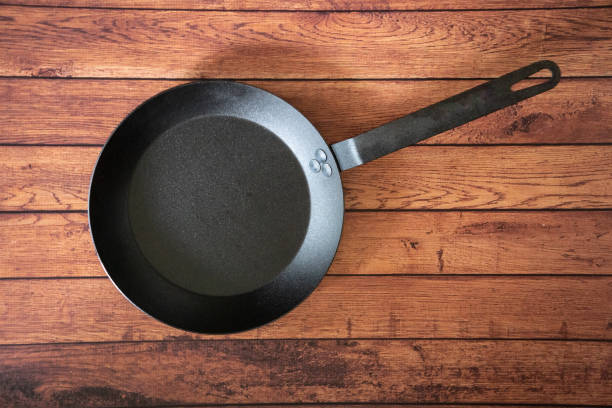
Carbon steel cookware is a popular choice among professional chefs and home cooks alike due to its excellent heat conductivity, durability, and versatility.
Made from a combination of iron and carbon, carbon steel pans are lighter than cast iron and heat up quickly and evenly, making them ideal for tasks like searing, frying, and sautéing.
They develop a natural non-stick patina with seasoning and can withstand high temperatures, making them suitable for use on stovetops, in ovens, and even on outdoor grills.
However, carbon steel pans require regular seasoning and maintenance to prevent rusting and maintain their non-stick properties. Despite this, many cooks appreciate their performance and affordability compared to other high-quality cookware options.
Advantages of Carbon Steel Cookware
- Excellent Heat Conductivity: Heats up quickly and evenly for precise cooking control.
- Lightweight: Lighter than cast iron, making them easier to handle.
- Durable: Resistant to scratches, dents, and warping with proper care.
- Versatile: Suitable for stovetop, oven, and outdoor cooking.
- Natural Non-Stick Surface: Develops a non-stick patina with seasoning, reducing the need for excessive oil.
- Affordable: Offers high-quality performance at a lower price point compared to some other materials.
Disadvantages of Carbon Steel Cookware
- Requires Seasoning: Needs regular seasoning to maintain its non-stick surface and prevent rust.
- Careful Maintenance: Must be dried thoroughly after washing to prevent rusting.
- Reactivity: Can react with acidic foods if not properly seasoned or maintained.
- Handle Heat: Handles can get hot during cooking, requiring the use of potholders or oven mitts.
Overall, carbon steel cookware is a versatile and durable option for those looking for high-performance cookware without the weight of cast iron. With proper seasoning and care, carbon steel pans can provide reliable cooking results for a wide range of dishes.
Aluminum

Aluminum cookware is valued for its lightweight nature and excellent heat conductivity, making it a popular choice for many kitchens.
It heats up quickly and evenly, allowing for precise temperature control and even cooking results. However, pure aluminum is reactive with acidic foods, so most aluminum cookware is either anodized or coated to prevent this reactivity and increase durability.
Anodized aluminum cookware has been treated to create a hard, non-reactive surface that resists scratches and corrosion.
On the other hand, coated aluminum cookware, such as non-stick pans, has a layer of non-stick material like Teflon or ceramic to enhance its cooking properties.
Despite its advantages, aluminum cookware can be prone to warping under high heat and may not be suitable for use with metal utensils or in the dishwasher.
Advantages of Aluminum Cookware
- Excellent Heat Conductivity: Heats up quickly and evenly for precise cooking control.
- Lightweight: Easy to handle and maneuver compared to heavier materials like cast iron.
- Affordable: Available at various price points, making it accessible for most budgets.
- Non-Reactive (Anodized/Coated): Anodized or coated aluminum is non-reactive with acidic foods, preventing metallic flavors and discoloration.
- Versatile: Suitable for a wide range of cooking methods, including stovetop, oven, and grill.
Disadvantages of Aluminum Cookware
- Reactivity (Uncoated): Pure aluminum can react with acidic foods, affecting taste and appearance.
- Durability: Prone to warping under high heat and may not be as durable as materials like stainless steel or cast iron.
- Not Dishwasher-Safe (Coated): Coatings on aluminum cookware can degrade over time if exposed to high heat or abrasive cleaning methods.
- Not Metal Utensil Safe (Coated): Coated aluminum cookware should be used with non-metal utensils to avoid damaging the coating.
Overall, aluminum cookware is a versatile and affordable option for those looking for efficient heat conduction and lightweight design in their kitchen tools. Anodized or coated aluminum versions offer added durability and non-reactivity for enhanced cooking performance.
Copper
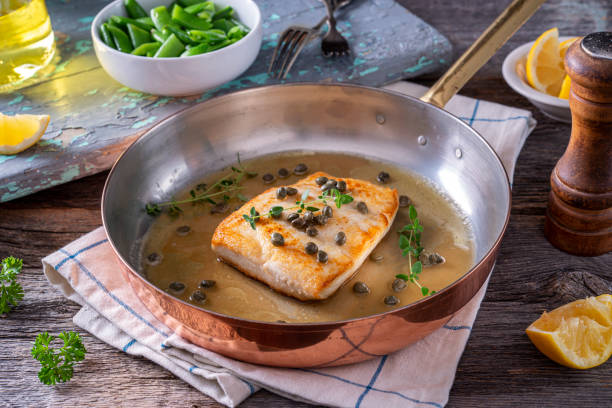
Copper cookware is highly prized for its exceptional heat conductivity, providing precise temperature control and even cooking results. It heats up quickly and responds rapidly to changes in temperature, making it ideal for tasks like sautéing, simmering, and caramelizing.
Copper pans are often lined with materials like stainless steel or tin to prevent reactivity with acidic foods and improve durability. However, pure copper cookware requires regular polishing to maintain its luster and prevent tarnishing.
While copper pans are admired for their beauty and cooking performance, they can be expensive and may not be dishwasher-safe.
Advantages of Copper Cookware
- Excellent Heat Conductivity: Distributes heat evenly for precise cooking control.
- Quick Response: Responds rapidly to changes in temperature, allowing for precise cooking techniques.
- Versatile: Suitable for a wide range of cooking methods, including stovetop, oven, and broiler.
- Non-Reactive (Lined): Lined with materials like stainless steel or tin to prevent reactivity with acidic foods.
- Aesthetic Appeal: Adds a touch of elegance to the kitchen with its shiny appearance.
Disadvantages of Copper Cookware
- Cost: Copper cookware can be expensive compared to other materials due to its superior heat conductivity and aesthetic appeal.
- Maintenance: Requires regular polishing to maintain its shine and prevent tarnishing.
- Reactivity (Unlined): Pure copper can react with acidic foods, affecting taste and appearance.
- Durability: Without proper care, copper cookware can dent, scratch, or warp over time.
- Not Dishwasher-Safe (Unlined): Unlined copper cookware is not dishwasher-safe and requires handwashing to prevent damage.
Overall, copper cookware is a favorite among professional chefs and cooking enthusiasts for its exceptional heat conductivity and elegant appearance. While it requires careful maintenance and can be expensive, its cooking performance and beauty make it a worthwhile investment for those who appreciate high-quality kitchen tools.
Ceramic
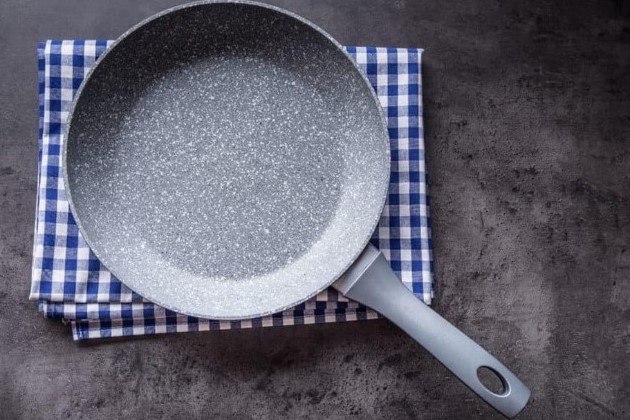
Ceramic cookware is valued for its non-stick properties, ease of cleaning, and attractive appearance. It is made from clay that is kiln-fired at high temperatures, creating a smooth and non-porous surface that resists sticking.
Ceramic pans are often coated with a layer of ceramic material, which provides a non-stick surface without the use of PFOA or other harmful chemicals found in some non-stick coatings.
This makes ceramic cookware a healthier option for cooking. However, ceramic pans may not be as durable as other materials and can chip or scratch if not handled carefully. Additionally, they may not perform well under high heat and are not suitable for use with metal utensils.
Advantages of Ceramic Cookware
- Non-Stick Surface: Food slides off easily, reducing the need for oil or butter during cooking.
- Healthier Option: Ceramic coatings are free from PFOA and other harmful chemicals found in some non-stick coatings.
- Easy to Clean: Non-porous surface is dishwasher-safe and resists staining and odors.
- Attractive Appearance: Available in a variety of colors and designs, adding aesthetic appeal to the kitchen.
- Affordable: Ceramic cookware is often more affordable compared to other non-stick options.
Disadvantages of Ceramic Cookware
- Durability: Ceramic coatings can chip or scratch with regular use, affecting their non-stick properties.
- Not for High Heat: Ceramic cookware may not perform well under high temperatures, leading to potential damage or warping.
- Careful Handling: Requires gentle handling to avoid chipping or scratching the ceramic coating.
- Not Metal Utensil Safe: Should be used with wooden or silicone utensils to prevent damage to the ceramic coating.
Overall, ceramic cookware is a popular choice for those looking for non-stick cooking without the use of chemicals. While it may require more careful handling and maintenance compared to other materials, its non-stick properties and attractive appearance make it a versatile option in the kitchen.
Glass
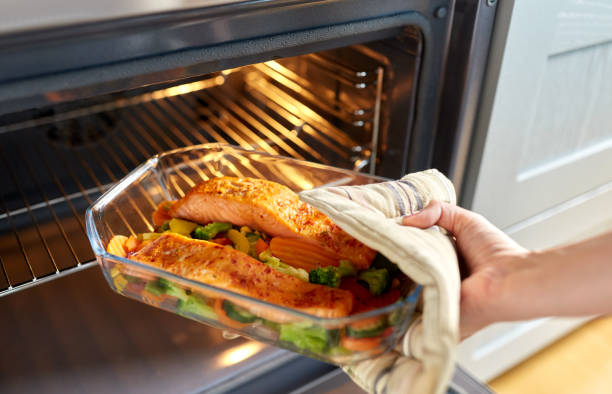
Glass cookware is valued for its non-reactive nature, allowing it to preserve the flavors and colors of food without imparting any metallic or chemical tastes.
It is made from tempered or borosilicate glass, which is heat-resistant and suitable for use in ovens, microwaves, and freezers. Glass pans are also non-porous, making them easy to clean and resistant to stains and odors.
However, glass cookware can be heavy and may not distribute heat as evenly as other materials. Moreover, it is more prone to breakage if not handled carefully, especially when exposed to rapid temperature changes.
Advantages of Glass Cookware
- Non-Reactive: Does not react with acidic or alkaline foods, preserving flavors and colors.
- Versatile: Suitable for use in ovens, microwaves, freezers, and even on the stovetop with certain models.
- Easy to Clean: Non-porous surface is dishwasher-safe and resists staining and odors.
- Transparent: Allows for easy monitoring of food while cooking.
- Healthier Option: Does not leach any chemicals into food, making it a safe choice for cooking.
Disadvantages of Glass Cookware
- Heat Distribution: May not distribute heat as evenly as materials like stainless steel or aluminum, leading to potential hot spots.
- Weight: Glass cookware can be heavy, especially in larger sizes, requiring careful handling.
- Breakage: More prone to breakage if dropped or exposed to rapid temperature changes.
- Limited Versatility (Some Models): Not all glass cookware is suitable for stovetop use, as some may shatter under direct heat.
Overall, glass cookware is a healthy and versatile option for cooking and baking, especially for dishes that require gentle heat or slow cooking. While it may have some limitations in terms of heat distribution and weight, its non-reactive properties and ease of cleaning make it a popular choice in many kitchens.
Know Your Pan Materials
“Know Your Pan Materials” is a comprehensive guide that educates readers about the various materials used in cookware, highlighting their unique properties, advantages, and considerations.
It covers essential pan materials like stainless steel, cast iron, non-stick coatings, copper, aluminum, ceramic, and glass.
The guide emphasizes key factors such as heat conductivity, durability, reactivity with acidic foods, ease of maintenance, and compatibility with different cooking methods.
Moreover, it provides practical insights into choosing the right pan material based on cooking preferences, budget, and maintenance requirements.
Frequently Asked Questions (FAQs) – Best Cookware Material
Q: Why is stainless steel considered one of the best cookware materials?
A: Stainless steel is prized for its durability, non-reactivity with foods, and easy maintenance. It’s a versatile choice that can handle high temperatures, making it perfect for searing, sautéing, and simmering dishes with precision.
Q: What makes cast iron a top contender among cookware materials?
A: Cast iron’s ability to retain and distribute heat evenly is unmatched. It’s also naturally non-stick when properly seasoned, adding a delightful depth of flavor to your meals. Plus, it lasts for generations, becoming better with each use.
Q: Why is copper often considered the chef’s choice in cookware?
A: Copper’s exceptional heat conductivity allows for precise temperature control, ideal for delicate sauces and precise cooking techniques. Its aesthetic appeal and quick responsiveness to temperature changes make it a favorite among professional chefs.
Q: What sets hard-anodized aluminum apart as a top-tier cookware material?
A: Hard-anodized aluminum combines the durability of metal with a non-stick surface, making it perfect for healthy cooking with minimal oil. Its scratch-resistant and dishwasher-safe properties ensure long-lasting performance and easy cleanup.
Q: Why are ceramic cookware gaining popularity as a healthy choice?
A: Ceramic cookware offers a non-toxic, non-reactive cooking surface that’s free from harmful chemicals like PFOA and PTFE. It’s ideal for health-conscious individuals looking for a safe and easy-to-clean option that still provides excellent heat distribution.
Q: What makes carbon steel a standout choice for professional chefs?
A: Carbon steel’s quick heat-up time and exceptional heat retention make it perfect for achieving restaurant-quality sears and caramelization. Its lightweight yet durable construction makes it a go-to for culinary experts seeking precision and performance.
Q: Why is enameled cast iron considered a versatile and stylish option?
A: Enameled cast iron combines the benefits of traditional cast iron with a colorful, non-reactive enamel coating. It’s perfect for both stovetop and oven use, offering easy cleanup and a pop of color in the kitchen.
Q: What sets multi-ply (clad) cookware apart as a top-performing choice?
A: Multi-ply cookware, featuring layers of different metals like stainless steel and aluminum, offers the best of both worlds: even heat distribution, durability, and non-reactivity. It’s a favorite among home cooks and professionals alike for its consistent performance.
Q: Why are non-stick coatings like PTFE and ceramic praised for their convenience?
A: Non-stick coatings provide an effortless cooking experience, allowing food to slide off the pan with ease and requiring minimal oil for healthier meals. They’re perfect for cooking delicate foods like eggs and fish without worrying about sticking or cleanup.
Q: What makes titanium cookware a durable and lightweight option for modern kitchens?
A: Titanium cookware combines strength with a feather-light design, making it easy to handle while offering excellent heat distribution and resistance to warping. Its non-porous surface is also easy to clean and resistant to scratches, ensuring long-lasting performance.
Conclusion
In conclusion, choosing the best cookware material depends on various factors such as cooking style, budget, maintenance preferences, and desired features like heat conductivity and non-stick properties.
Stainless steel offers durability and versatility, while non-stick pans are excellent for low-fat cooking and easy cleanup. Cast iron provides even heating and can be used on different heat sources, and copper offers superior heat conductivity for precise cooking.
Hard-anodized pans combine durability with non-stick properties, making them suitable for everyday use.
Ultimately, the best cookware material for you will align with your cooking needs and personal preferences, ensuring enjoyable and successful culinary experiences.
Other Articles You May Also Like: